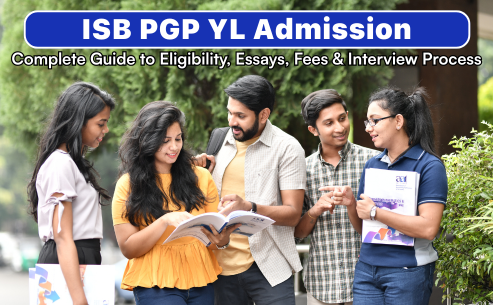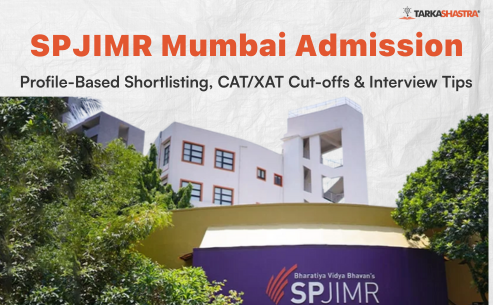In the competitive world of MBA admissions, standing out from the crowd is essential. The Written Ability Test (WAT) is a crucial component of this process. This guide will provide you with essential insights into WAT preparation, including its definition, structure, and top tips for success.
“Tarkashastra made my MBA CET registration seamless with their guidance and resources at every step.”
Join our classes today.
Add Your Heading Text Here
What is WAT?
The Written Ability Test (WAT) is a short essay writing exercise conducted by many MBA programs in India, including the prestigious Indian Institutes of Management (IIMs), XLRI, SPJIMR, and others. It replaced the Group Discussion (GD) round in several institutes due to its ability to individually assess candidates on:
- Clarity of Thoughts
- Analytical Ability
- Writing Skills
- Knowledge of Current Affairs
- Critical Thinking
- Time Management
Typically, the WAT is conducted after clearing entrance exams like the CAT (Common Admission Test) and involves writing an essay on a given topic within a limited timeframe, usually 15-30 minutes.
WAT topics range from current events to social issues, philosophical ideas, or business and economic concepts. Candidates typically have 15 to 30 minutes to write an essay of 200 to 400 words.
The essay is evaluated on structure, content, coherence, grammar, and the ability to present logical arguments.
Why is WAT Important?
WAT has become vital in the selection process. Here’s why excelling at WAT matters:
- Individual Performance: Unlike group discussions, WAT highlights your individual thought process.
- Academic and Analytical Skills: Institutes seek candidates who think critically and present ideas clearly, which WAT tests.
- Preparation for Personal Interview (PI): Interviewers often refer to the WAT essay during interviews, making WAT valuable prep for the PI round.
- Knowledge of Current Affairs: WAT tests your awareness of social, political, or economic issues, providing a chance to show your holistic understanding of what’s going around in the world.
Format of the Written Ability Test Round
The Written Ability Test (WAT) round format can vary slightly depending on the specific program or institution. Below is a general overview of what to anticipate:
- Time Limit: The duration of the WAT is 15-20 minutes, although some programs may allocate more or less time.
- Number of Prompts: Generally, you will receive one essay prompt. Some programs might offer two prompts and request that you select one.
- Prompt Type: The prompt may range from a current affairs topic to a general management principle or an abstract concept. It is crucial to be prepared for any subject matter.
- Word Limit: There is usually no strict word limit for the WAT, but most essays will be approximately 250-350 words in length. Strive to develop your ideas thoroughly while avoiding unnecessary digressions.
- Writing Materials: You will typically be supplied with a pen and paper for the WAT. Some programs may permit laptop use, but this is not always the case. It is advisable to consult the specific program guidelines beforehand.
- Grading Criteria: The WAT is usually assessed based on several factors, including:
- Content: The relevance and depth of your response to the prompt.
- Critical thinking: Your ability to analyse information, form independent opinions, and support them with evidence.
- Communication: The clarity, grammar, and vocabulary of your writing.
- Structure: The organization and coherence of your essay.
A basic structure for Written Ability Test (WAT)
There are numerous methods to structure an essay; however, a particularly robust and effective structure comprises the following components:
- Introduction: This section is straightforward. Begin with a sentence or two that restate the topic and outline the flow of your essay. It should set the tone for the remainder of the essay.
- Body: This is where the main content resides. Include facts, opinions, arguments, counter arguments, citations, and other relevant details, forming the core of your essay.
- Conclusion: The conclusion may serve as a summary of the points detailed in the body. For argumentative essays, where a stance is taken, the conclusion should concisely encapsulate your position.
Why Structure Matters in WAT
A well-structured essay is the backbone of a successful WAT. Structuring your essay into an introduction, body, and conclusion ensures clarity and coherence. The introduction sets the stage for your thoughts, the body presents arguments and evidence, and the conclusion ties everything together, leaving a lasting impression.
WAT Preparation Tips
Preparing for the Writing Ability Test (WAT) can significantly enhance your performance and confidence. Here are some refined strategies to facilitate adequate preparation:
- Understand the Format: Acquaint yourself with the typical WAT format, which often involves composing an essay or passage on a topic. Practice writing within the stipulated time limit of 25-30 minutes.
- Are you writing for yourself?: Consider who your audience is. Are you writing for yourself or for the B-School panelists? Naturally, it’s for yourself. Therefore, ensure that your writing is crafted with care. Analyze what the panelists would find engaging. Keep in mind, you may be questioned on what you’ve written in the WAT.
- The first line: The opening line of your WAT article serves as the primary hook. It determines whether the reader will stay engaged. The essence of your article can often be discerned from this initial line.
- Read Regularly: Develop a habit of reading, including newspapers, articles, and essays. This practice improves your vocabulary and exposes you to diverse writing styles.
- Create a mind map: Upon reading the topic, begin outlining the structure of your content. Plan the order of your quotes, facts, and examples. This approach will help maintain a consistent structure and ensure you don’t overlook important points.
- Practice Writing Prompts: Engage with various writing prompts to enhance your ability to articulate thoughts on different subjects. Solicit feedback from mentors to refine your writing style.
- Work on Clarity and Conciseness: Concentrate on expressing your ideas with clarity and brevity. Avoid unnecessary complexity and ensure that your thoughts are logically structured.
- Brush Up on Grammar and Vocabulary: Strengthen your grammar proficiency to elevate the quality of your writing. Employ a varied vocabulary, ensuring alignment with the context of your writing.
- Use transition words: Employ transition words such as furthermore, nevertheless, besides, and in addition, to maintain the flow of your WAT article and seamlessly transition between ideas.
- Stay Informed about Current Affairs: Many WAT topics pertain to current events or contemporary issues. Stay informed about global happenings to add depth and relevance to your essays.
- Create a Writing Schedule: Establish a consistent writing schedule to practise regularly. This approach aids in building endurance and improving writing speed.
- Mock Tests: Conduct practice WAT tests under timed conditions to emulate the actual test environment. Review your performance to identify areas for improvement.
- Be Authentic in Your Writing: Cultivate your unique writing voice as you practise. Authenticity lends a personal touch to your essays.
- The importance of prioritising: If you find yourself overwhelmed with ideas, prioritise your content carefully. It’s essential to adhere to the topic and focus on relevant information. Avoid exceeding the word limit.
- Provide examples and citations: If you have consulted research papers or case studies related to the WAT topic, use them as citations. Employ valid examples to substantiate your viewpoints.
- Time Management: Effective time management is crucial when writing the WAT. From creating a mind map to noting down key points, ensure you utilise the allotted time efficiently.
- Conclusion: The conclusion should summarise your arguments succinctly. Avoid repetition of the same words used in the main body of the WAT.
By integrating these strategies into your WAT preparation regimen, you can enhance confidence and competence in effectively expressing your thoughts in written form.
IIM WAT Tips : Don’ts
The IIM WAT round is a critical component of the IIM selection process, carrying significant weight. Ensuring that no mistakes are made and that nothing is overlooked while writing the WAT is essential. Below are some of the key “don’ts” for the IIM WAT that should be observed:
- Exceeding the word limit: It is imperative not to exceed the word limit under any circumstances.
- Beating around the bush: Avoid writing irrelevant content. Focus on what is pertinent to the topic. Complicating the WAT article is not advisable.
- Detailing the introduction and conclusion: The introduction and conclusion should be concise. The body of the article should be detailed with arguments and examples.
- Not giving credits: Ensure that any quotes or content taken from other sources are appropriately credited to the author. This is a crucial aspect of the IIM WAT.
- Making grammatical errors: Pay attention to grammar, spelling, and punctuation.
- Complicating your article with big words: As previously mentioned, avoid using unnecessarily complex words. The article should be easily understandable.
- False content: Using fabricated examples to support your viewpoint is not advisable. Use relevant real-life examples only.
These are the top IIM WAT tips that Tarkashastra’s IIM students adhere to. These Written Ability Test tips will aid you in gaining admission to the top IIMs.
Conclusion
Mastering the Written Ability Test (WAT) is essential in the MBA admission process. By understanding its purpose, practising diligently, and honing your writing skills, you can effectively convey your ideas and stand out to selection committees. Remember, WAT is not just about language proficiency. It’s about articulating your thoughts coherently and persuasively.
Tarkashastra offers comprehensive coaching programs for aspiring MBA students to help them excel in WAT preparation and achieve their career goals. Our expert faculty provides personalised guidance, helping you refine your writing skills and boost your confidence.
Sign up for our courses today and take the first step towards realising your MBA dreams.
FAQs
-
1. What is WAT in CAT?
The Written Ability Test (WAT) in CAT (Common Admission Test) assesses a candidate’s ability to communicate effectively through writing. It involves composing essays on various topics to evaluate articulation, clarity of thought, and logical structuring of ideas.
-
2. Why is WAT important in the CAT selection process?
WAT is crucial because it helps institutes gauge a candidate’s written communication skills, essential for effective management and leadership. It also reflects the candidate’s critical thinking and ability to present arguments clearly and concisely.
-
3. What is the structure of the WAT in CAT?
The WAT typically requires candidates to write an essay on a topic within a specified word limit. The structure often comprises an introduction, a detailed body with well-articulated arguments, and a concise conclusion.
-
4. How long is the typical WAT essay in CAT?
The typical length for a WAT essay is about 250-350 words. This limitation encourages precision and clarity in conveying ideas.
-
5. What types of topics are commonly asked in WAT?
Common topics in WAT range from current events, societal issues, business and economics, ethics, and philosophy to abstract topics, requiring candidates to demonstrate diverse knowledge and analytical abilities.
-
6. How is WAT scored in the CAT selection process?
WAT is scored based on several criteria, including coherence, grammar, vocabulary, structure, and relevance of arguments. The essay is evaluated for its logical flow and the ability to justify viewpoints with valid arguments and examples.
-
7. What skills are evaluated through WAT?
WAT evaluates skills such as analytical thinking, coherence and clarity in writing, grammar and vocabulary usage, and the ability to argue coherently and support viewpoints with valid examples.
-
8. What are the critical elements of a well-structured WAT essay?
A well-structured WAT essay includes a compelling introduction, coherent and logically organised body paragraphs presenting arguments and examples, and a succinct conclusion that wraps up the arguments effectively.
-
9. How should I approach a controversial or abstract topic in WAT?
Approach such topics by clearly defining your stance in the introduction. Use logical arguments and real-life examples to substantiate your points. Ensure the essay remains objective and balanced, avoiding emotional bias.
-
10. What are the best practices for preparing for WAT?
To prepare for WAT, practice writing essays regularly, read extensively to stay informed on various subjects, seek mentor feedback, and engage in mock tests to simulate actual test conditions.
-
11. How can I improve my essay writing for WAT?
Improve your essay writing by practising regularly, diversifying your vocabulary, refining grammar skills, reading quality essays to understand different writing styles, and integrating feedback from critiques.
-
12. How much time should I allocate for each part of my WAT essay (introduction, body, conclusion)?
Allocate approximately 20% of your time for the introduction to set the context, 60% for the body to develop arguments with examples, and 20% for the conclusion to summarise your viewpoints effectively.







